Editor’s note: This is Serdang MP Ong Kian Ming’s full parliamentary speech on the Election Commission’s final redelineation report on Mar 28, 2018.
MP SPEAKS | Thank you, Tan Sri Speaker for allowing me to take part in this very important debate.
Firstly, I would like to strongly urge the prime minister to be present to answer the questions pertaining to this report after the tabling of this report for the second reading. This is his constitutional responsibility.
Article 8 of the 13th Schedule of the Federal Constitution clearly states that the Election Commission, having completed the delimitation exercise report, must submit the report to the prime minister.
In Article 9 of the 13th Schedule of the Federal Constitution, it is also clearly stated that the prime minister is responsible to lay the report before the Members of Parliament in the House of Representatives, with or without modifying, the recommendations in the report.
Has your constituency been affected by the new electoral boundaries?
Since it is the prime minister who receives the final delimitation report from the EC and since only the prime minister can make modifications to the delimitation report before it is tabled in Parliament, we need his presence in Parliament to explain to us, the details in the delimitation report, and to inform us exactly where he has made modifications to the final delimitation exercise report which has been tabled in Parliament.
I hope that the members of this house will agree with me that we need the prime minister in the house to answer questions directly especially since such a report is only tabled once every 10 years, on average.
No parliament seats added
Secondly, I would like to draw the attention of this house to the unprecedented nature of this 2018 delimitation exercise for Peninsular Malaysia.
In each of the past five delimitation exercises for Peninsular Malaysia, new parliament seats were added.
For example, in the first delimitation exercise for Peninsular Malaysia in 1958, 52 parliament seats which were used in the 1955 pre-independence elections were divided into two seats each to make up a total of 104 parliament seats.
In the second delimitation exercise for Peninsular Malaysia in 1974, 10 parliament seats were added to make up a total of 114 parliament seats.
In the third delimitation exercise for Peninsular Malaysia in 1984, 19 parliament seats were added to make up a total of 133 parliament seats.
In the fourth delimitation exercise for Peninsular Malaysia in 1994, 12 parliament seats were added to make up a total of 145 parliament seats.
And finally, in the fifth delimitation exercise for Peninsular Malaysia in 2003, a total of 21 parliament seats were added to make up 166 parliament seats, including WP Labuan (Figure 1).

Figure 1: Changes in the number of state and parliament seats in Peninsular Malaysia in each delimitation exercise from 1958 to 2003 (Source: 2018 EC delimitation report)
Why were no parliament seats added in this 2018 delimitation exercise even though the number of voters, especially in certain urban areas, has grown significantly since the 2003 delimitation exercise?
The total number of voters in the electoral roll has increased by more than 3 million since the 2003 delimitation exercise, an increase of 37 percent.
In Selangor, the number of voters has increased by 52 percent or 709,618 voters.
In Terengganu, the number of voters has increased by 258,093 or 63 percent. In Kelantan, the number of voters has increased by 284,889 voters or 43.4 percent.
The increase in voters, especially in percentage terms, has been significant not just in urban states like Selangor but also in less urban states like Kelantan and Terengganu.
In other words, the decision by the EC not to increase any parliament seats is unfair not just to voters in urban states like Selangor but also in less urban states like Kelantan and Terengganu (Table 1).
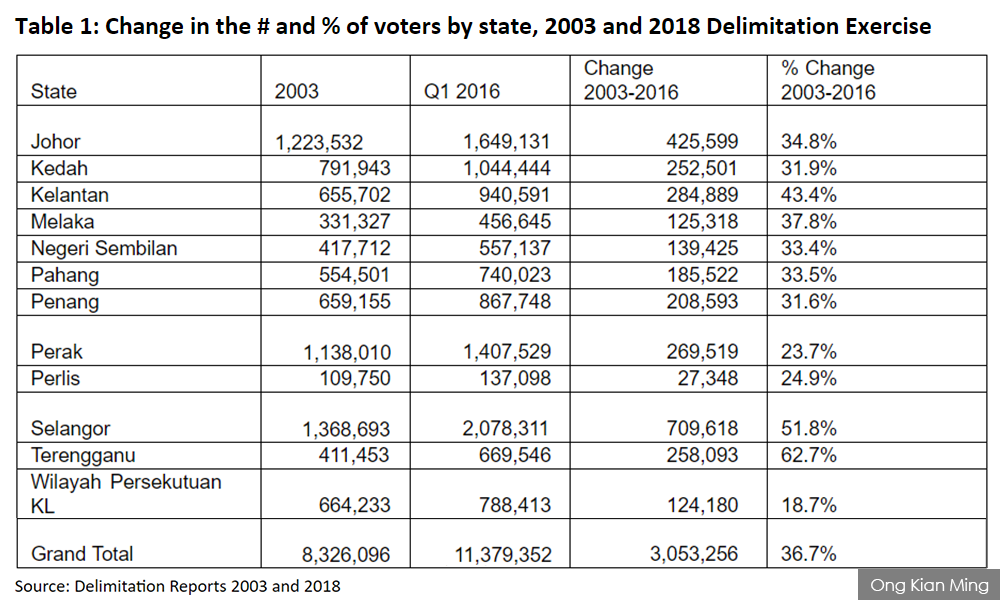
Table 1: Change in the number and percentage of voters by state in 2003 and 2018 delimitation exercises (Source: EC delimitation reports 2003 and 2018)
If we examine the average number of voters by parliament seat, we find similar patterns. The number of voters per seat by state in Selangor has increased from 62,213 to 94,469, an increase of 32,255. The number of voters per seat in Terengganu has also increased from 51,432 to 83,693, an increase of 32,262 which is the highest increase by parliament seat in Peninsular Malaysia (Table 2).
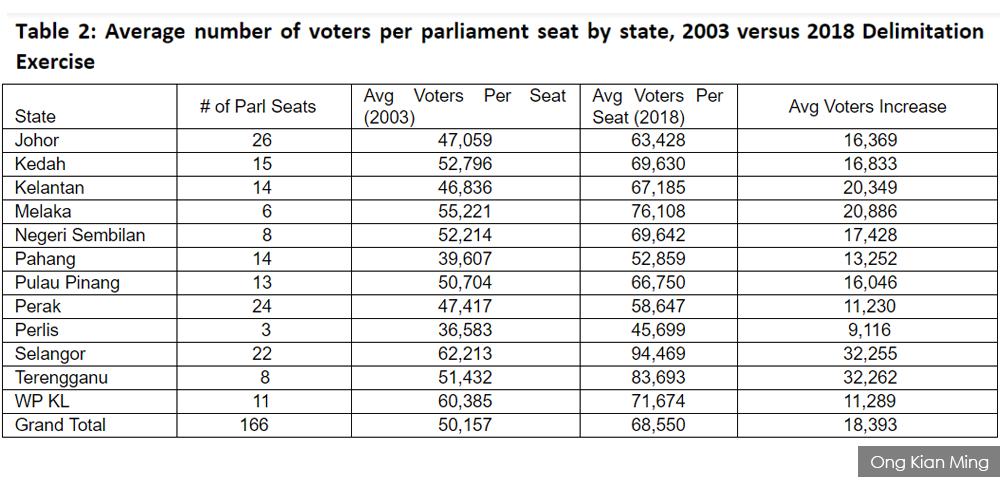
Table 2: Average number of voters per parliament seat by state in 2003 versus 2018 delimitation exercises
I want to remind my colleagues from the states of Perlis, Kedah, Kelantan and Terengganu, especially from BN, that no parliament seats were added in any of these states in the 2003 delimitation exercise. Since there have been no parliament seats added in these states in this latest delimitation exercise, this means that the voters in these 4 states have been once again deprived from seeing an increase in the number of parliament seats.
I want to stress that it is the responsibility of the EC to ensure that the delimitation exercise is conducted fairly.
If parliament and state seats need to be added to fulfil the conditions of Article 2 of the 13th Schedule, then the EC should do so.
It is the responsibility of the Prime Minister to ensure that there is sufficient support for the delimitation exercise including obtaining a two-thirds support in Parliament in order to amend Article 46 of the Federal Constitution.
If the delimitation exercise is done fairly and accurately, there is no reason why the prime minister would have difficulty getting a two-thirds support in Parliament and also the support of the respective state governments.
Is it possible that the EC did not increase the number of parliament seats because this would have advantaged the opposition?
Based on the 2013 general election results, the average number of voters for the 80 seats won by the opposition, according to the proposed delimitation report, is 83,150 voters compared to an average of 54,969 voters in the 86 seats won by the BN (Table 3).
If seats were to be added in order to reduce the discrepancy between the number of voters per seat, it would most likely have been in areas which were won by the opposition in GE13.

Table 3: Average number of voters per seat (BN versus opposition) according to the 2018 delimitation report. Winners based on GE13 results.
Inconsistent rural weightage
Thirdly, I would like to ask the prime minister for his understanding of the concept of rural weightage as stated in Article 2(c) of the 13th Schedule in the Federal Constitution, which states that “the number of electors within each constituency in a State ought to be approximately equal except that, having regard to the greater difficulty of reaching electors in the country districts and the other disadvantages facing rural constituencies, a measure of weightage for area ought to be given to such constituencies”.
In response to an article in The Economist entitled “How Malaysia’s next election will be rigged” published on March 8, 2018, the EC published their own rebuttal on March 13, entitled “No manipulation of the electoral system in GE14 to help a certain party win”.
One of the points raised in this article is that the size of parliament and/or state seats in rural areas are larger, but their populations are smaller whereas for urban seats, their size is smaller but their population is higher.
I want to direct the prime minister’s attention to the parliament seat of P16 Baling, a rural seat in Kedah, and P9 Alor Setar, an urban seat, also in Kedah.
P16 Baling is more than 10 times the size of P9 Alor Setar but it has 94,809 voters compared to only 73,687 voters for Alor Setar. So not only does a rural seat like P16 Baling cover a much larger area, it also has more voters than an urban seat like P9 Alor Setar (Figure 2). Why did the 2018 delimitation exercise not correct this imbalance?
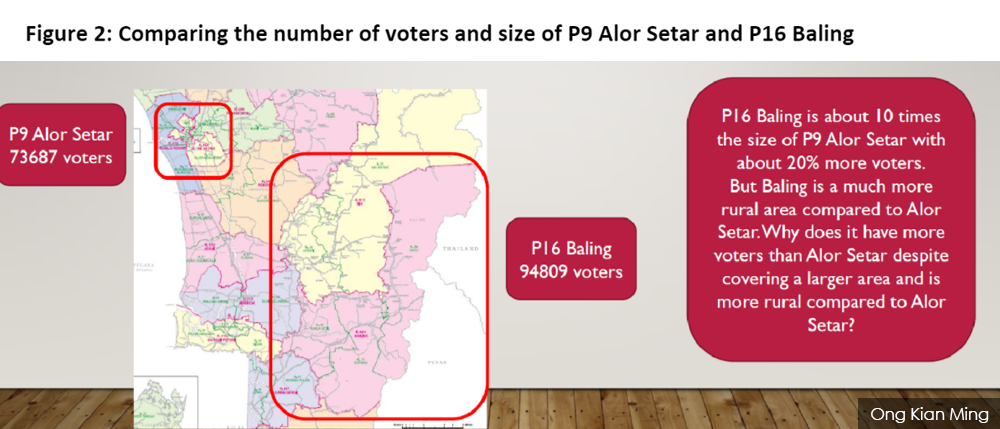
Figure 2: Comparing the number of voters and size of P9 Alor Setar and P16 Baling
I also want to refer the prime minister to P92 Sabak Bernam and P94 Hulu Selangor.
P94 Hulu Selangor is about 5 times the size of P92 Sabak Bernam but it has 86,599 voters which is more than twice the number of voters as P92 Sabak Bernam which has 37,126 voters. This is despite the fact that Hulu Selangor is much less connected and more inaccessible compared to Sabak Bernam (Refer to Figure 3 below).
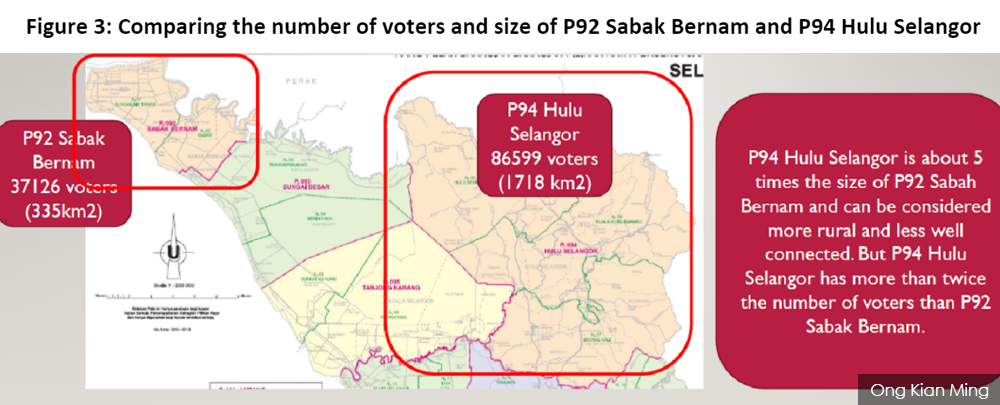
Figure 3: Comparing the number of voters and size of P92 Sabak Bernam and P94 Hulu Selangor
I want to refer the prime minister to P103 Puchong and P104 Subang. These seats are approximately equal in their area size, and both seats are within the jurisdiction of the Subang Jaya City Council (MBSJ). Both seats are definitely urban seats. And yet, P104 Subang has 128,330 voters while 103 Puchong only has 82,698 voters.
Why are two urban seats which are side by side and which are under the same local council have a difference of 45,000 voters? Why does P104 Subang have 50 percent more voters than P103 Puchong? (Refer to Figure 4 below)

Figure 4: Comparing the number of voters and size of P103 Puchong and P104 Subang
The inconsistent application of the rural weightage principle makes a mockery of the EC’s response to the article in The Economist. It is clear from the examples that I have shown that the principle of rural weightage was not followed by the EC.
Maintaining local ties
Fourthly, I want to ask the Prime Minister about the need to maintain local ties as stipulated in Article 2(d) of the 13th Schedule of the Federal Constitution: “Regard ought to be had to the inconveniences attendant on alterations of constituencies, and to the maintenance of local ties.”
In the EC’s response to the article in The Economist, it emphasised that the delimitation exercise was conducted “for the interest and welfare of the voters and to make it easier to the elected representative to service their voters”.
The need to maintain local ties is understood to mean that the EC, should as far as possible, not have a parliament or state constituency cover more than one local council.
I want to draw the attention of the prime minister to the proposed parliamentary constituency of P106 Damansara, which is now Petaling Jaya Utara (PJ Utara). The number of voters in this constituency increased to 150,439, with the inclusion of another state seat N37 Bukit Lanjan. Most of P106 Damansara is under the jurisdiction of the Petaling Jaya City Council (MBPJ).
But for some strange reason, the EC saw fit to bring in polling stations which are under the Selayang City Council (MPS) and the Shah Alam City Council (MBSA) into P106 Damansara! The EC made this decision despite the many objections filed by voters in PJ Utara on the grounds of “maintenance of local ties” in Round One of the public hearing for the delimitation exercise.
Local inquiry process
Fifthly, I want to ask the prime minister about the process of the local inquiry as stipulated in Article 5 of the 13th Schedule of the Federal Constitution. In the second public hearing in Selangor, after the publication of Syor 2, a total of 748 objections were received. Out of these 748 objections, 689 (or 92 percent) were rejected because they did not fulfil the conditions for a local inquiry.
A larger number of these objections were filed by voters in PJ Utara, PJ Selatan and Kelana Jaya. The reason for the EC to reject these objections was because the boundaries of these constituencies were not changed from the boundaries used in GE13 and the boundaries proposed in Syor 2 of the delimitation exercise for Selangor.
And yet, the boundaries of all these seats were affected when the EC reverted back to the recommendations proposed in Syor 1 in the final delimitation report. This is despite the fact that the EC agreed to the objections raised by the voters in P106 PJ Utara during the first public hearing of the delimitation exercise on the basis of maintaining local ties (Figure 5).
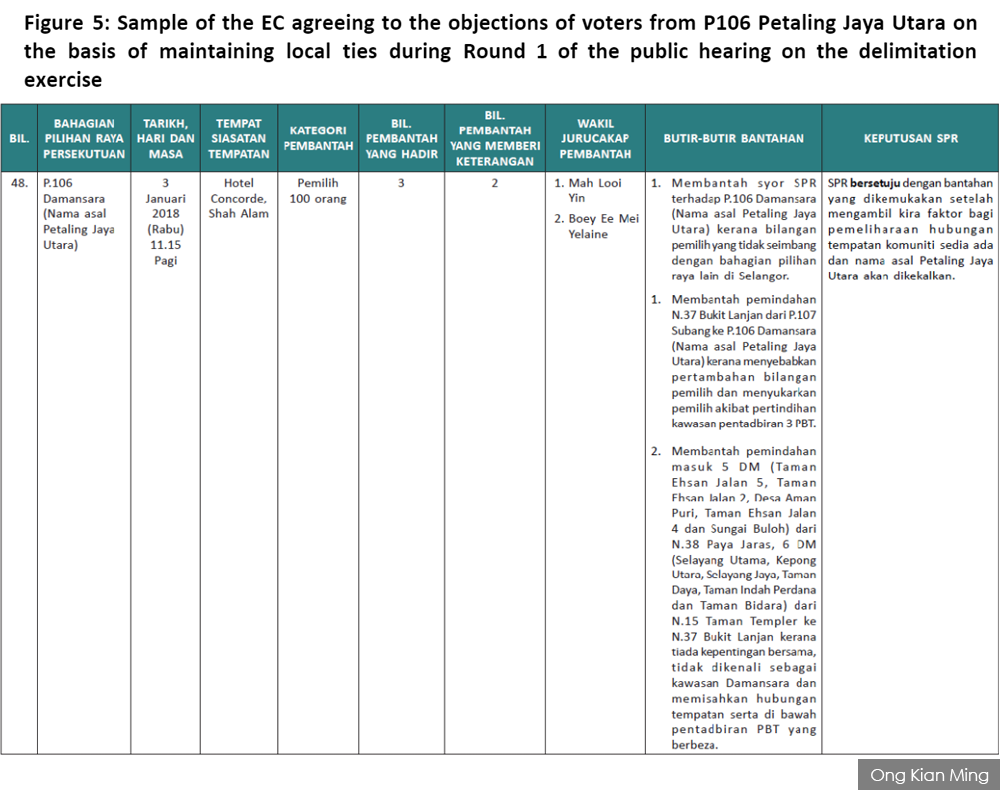
Figure 5: Sample of the EC agreeing to the objections of voters from P106 Petaling Jaya Utara on the basis of maintaining local ties during Round 1 of the public hearing on the delimitation exercise
This means that the rights of the voters in these seats have been taken away from them by the EC. They did not have a chance to have their objections heard by the EC. They did not have a chance to let the EC know that they object if the final delimitation report were to follow the recommendations proposed in Syor 1 of the delimitation exercise.
The issue of whether they had a right to be called up for the second public hearing is now the subject of the court case filed by Maria Chin and 106 other plaintiffs against the EC, the prime minister and also the speaker of the House of Representatives.
In Attachment IX of the second volume of the final delimitation report, a total of 457 recommendations were recorded by the EC for the second public hearing in Selangor.
As far as I can see, these were recommendations proposed by individuals representing NGOs such as resident associations, religious bodies, JKPs and JKKKs. Most of these recommendations were in support of Syor 1 and objecting to Syor 2 for Selangor.
I want to ask the prime minister to state if these recommendations were according to Article 5 of the 13th Schedule of the Federal Constitution, which means that these recommendations were by a group of 100 voters from that constituency. If they were not supported by a group of 100 voters from that specific constituency, then the EC would be guilty of violating the constitution.
Further ethnic segregation
Sixthly, I want to issue a challenge to my fellow MPs from MCA, Gerakan and MIC.
I have read in many newspaper reports and from many forums that MCA, Gerakan and MIC does not agree with this delimitation exercise because of how it segregates the races further and has reduced the number of heterogenous constituencies.
This is dangerous, according to MCA, Gerakan and MIC leaders, because it could lead to further racial polarisation in this country. I agree with the concerns of my fellow MPs from these parties.
I would like to draw your attention to a few selected parliamentary constituencies.
After this delimitation exercise, P74 Lumut will have 71 percent Malay, 16 percent Chinese, 12 percent Indian and 1 percent Other voters.
Before the delimitation exercise, P74 Lumut had 51 percent Malay, 35 percent Chinese, 12 percent Indian and 1.5 percent Other voters.
The delimitation exercise has made P74 Lumut into a significantly Malay majority parliament seat. It was contested by MCA in GE13. It is likely to be contested by Umno in GE14.
After this delimitation exercise, P107 Sungai Buloh will have 64 percent Malay, 23 percent Chinese, 12 percent Indian and 1 percent Other voters.
Before the delimitation exercise, P107 Sungai Buloh had 47 percent Malay, 38 percent Chinese, 13 percent Indian, 2 percent Other voters.
The delimitation exercise has made P107 Sungai Buloh into a Malay-majority parliament seat. It was contested by MIC in GE13. It will likely be contested by Umno in GE14.
After this delimitation exercise, P109 Kapar will have 69 percent Malay, 16 percent Chinese, 15 percent Indian voters. Before the delimitation exercise, P109 Kapar had 51 percent Malay, 34 percent Chinese, 14 percent Indian voters.
The delimitation exercise has made P109 Kapar into a significantly Malay-majority parliament seat. It was contested by MIC in GE13. It will likely be contested by Umno in GE14.
After this delimitation exercise, P124 Bandar Tun Razak will have 58 percent Malay, 31 percent Chinese, 8 percent Indian, 2 percent Other voters.
Before the delimitation exercise, P124 Bandar Tun Razak had 52 percent Malay, 37 percent Chinese, 9 percent Indian, 2 percent Other voters.
The delimitation exercise has increased the percent of Malay voters in this seat. It was contested by MCA in GE13. There is a high possibility that Umno will contest in this seat in GE14.
Since this delimitation exercise seems to have been largely done to benefit Umno and since many MCA, Gerakan and MIC leaders have come out to openly express their reservation about this delimitation exercise, I challenge the MCA, Gerakan and MIC MPs here today to vote against this delimitation exercise to tell the public that you do not support this kind of ethnic gerrymandering.
The failure to do so will mean that you are incapable of standing up against Umno and have failed the people of Malaysia in fighting for a fairer and cleaner electoral system.
I also challenge fellow MPs from Sabah to object to this delimitation report as a protest against the fact that the Sabah delimitation report, which proposed a 13 seat increase in the Sabah state assembly, has not been tabled in this Parliament session.
The failure to do so would mean that you have failed in your duties to defend the rights of the Sabahans and will show that you are subservient to your political masters at the federal level.
With this, I propose to reject this delimitation report!
Bersih! Bersih! Bersih!
ONG KIAN MING is MP for Serdang and head of Penang Institute in Kuala Lumpur.
The views expressed here are those of the author/contributor and do not necessarily represent the views of Malaysiakini.

